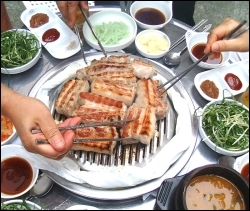I adore Maangchi and her culinary delights. Samgyeopsal is the typical Korean dish I introduce to friends who have not had a lot of experience with Korean food. It requires a hot-plate type device for cooking, but I’ve always used a skillet to great effect – I’ve never been a big fan of the griddle in the middle of the table like they will serve it to you in Korea, Japan or any Korean barbecue restaurant that strives for authenticity. It adds to the experience but perhaps not to the flavor. It is important to be able to drain the pork fat that accumulates or you can modify the recipe for a smaller slice of ham. I tend to skip the pork belly entirely and just do the whole thing with really thick bacon. The sauces are what makes this dish in my opinion. It is quick, easy, and delicious as well as being a great introduction to Korean popular cuisine. Samgyeopsal means three-layered flesh and is in reference to the pork belly’s appearance. Pork is often cheaper in South Korea than beef so this dish is quite popular yet the caveat with bacon remains: don’t eat it all the time unless you want to die of an early heart attack. Note the proper technique for eating the Samgyeopsal, wrapped in lettuce with sauce. Also note that in Korea metal chopsticks are acceptable for eating and cooking, whereas metal chopsticks tend to be taboo in other East Asian countries (e.g. in Japan metal chopsticks are used to pick the bones out of the urns containing the cremated remains of a deceased loved one). I prefer to cook with wooden or plastic chopsticks, particularly of the Chinese variety which are long and thin, thus keeping a perfect distance between my hands and the heat. For eating, I prefer the shorter, stubby Japanese chopsticks simply because I have the most extensive history with them. Plastic and wood also do not scar up non-stick cookware surfaces. Maangchi’s recipe for Samgyeopsal is as follows:
Ingredients:
pork belly or thick bacon variant
pajori (green onion salad)
ssamjang (soybean paste sauce)
skillet or grill plate – Maangchi emphasizes the plate’s need to allow pork fat to run off or be easily disposed of so keep that in mind when cooking.
for 4 servings
3 pounds of pork belly (fresh or pre-sliced frozen), green onions, carrot, green chili peppers, garlic, lettuce, mushrooms, hot pepper flakes, soy sauce, sugar, honey, Korean hot pepper paste (very deep red color – not hard to find),soybean paste, sesame seeds, and sesame oil.
Steps:
Cut the pork belly into bite sized pieces. Put it on a plate and put in the refrigerator for a couple of hours.
In the meantime, make the pajori green onion salad:
Shred approximately five cups of green onions. In a bowl large enough to mix things in combine a quarter cup of soy sauce, 2 tbs of hot pepper flakes, 2 ts sugar (or honey), 1 tbs sesame seeds, 1 tbs sesame oil.
Now make the samjang soybean paste sauce:
A quarter cup of soybean paste, 2 tbs of hot pepper paste, a stalk of chopped green onion, a minced clove of garlic, 2 ts of honey (or sugar), 2 ts of sesame seeds, 1 tbs of sesame oil.
Prepare the lettuce, carrots and mushrooms by cutting them into bite-sized pieces and placing them aside on a plate. Slice two dozen pieces of garlic.
Turn on the grill, coat with sesame oil to prevent sticking, arrange pork and vegetables on the grill and remove pieces as they are cooked. Be careful of burning the pork.
Eat by stuffing pork, vegetables and sauce of choice into a leaf of lettuce and eat all at once. Simple, easy, and delicious. Stay tuned for more Korean recipes in the future! I won’t steer you wrong and I will always warn before springing something bold on you guys! This is as international friendly as they come, because outside of a couple of religions who have forbidden the consumption of pork, everyone loves to eat what amounts to glorified bacon. Enjoy!
